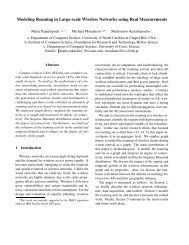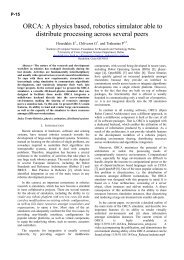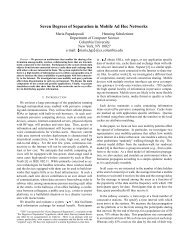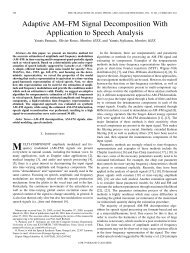Master Thesis - ICS
Master Thesis - ICS
Master Thesis - ICS
Create successful ePaper yourself
Turn your PDF publications into a flip-book with our unique Google optimized e-Paper software.
Computer Science Department<br />
Antonis Misargopoulos<br />
I-SOFT Applications which<br />
couple supercomputers<br />
remote instruments,<br />
immersive environments,<br />
data systems<br />
Developed by users, static capacity<br />
information used for scheduling<br />
some applications<br />
Centralized scheduler<br />
maintained user queues<br />
and static capacities,<br />
application served as<br />
“first come, first served”<br />
IOS Real-time, iterative,<br />
automatic target<br />
recognition applications<br />
Applications represented as a<br />
dependency graph of subtasks, each<br />
of which can be assigned one of<br />
possible algorithms<br />
Off-line genetic<br />
algorithm indexed by<br />
dynamic parameters used<br />
to determine mapping for<br />
current iteration<br />
SPP(X) Base serial language X<br />
and structured<br />
coordination language<br />
Compositional performance model<br />
based on skeletons associated with<br />
program structure<br />
Determination of<br />
performance model for<br />
candidate schedules with<br />
minimal execution time<br />
Dome C++ extended programs Program rebalanced based on past<br />
performance, after some numbers of<br />
Dome operations<br />
Globally-controlled or<br />
locally-controlled load<br />
balancing<br />
Figure 3.1: Some efforts on developing high-performance Grid scheduler<br />
Figure 3.1 summarizes major current efforts in developing high-performance grid<br />
schedulers. The way in which the scheduling model is developed for each of these<br />
projects, illustrates the different decisions that can be made, and experience with<br />
application will give some measure of the effectiveness of these decisions. In the next<br />
sections, we discuss these efforts from the perspective of the constituent components of<br />
their scheduling models.<br />
Program Model<br />
Program models for high-performance schedulers generally represent a program by a<br />
(possibly weighted) dataflow-style program graph, or by a set of program characteristics<br />
that may (or may not) include a structural task dependency graph.<br />
Dataflow-style program graphs are a common representation for grid systems.<br />
Dome[85] and SPP(X) [83] provide a language abstraction for the program which is<br />
compiled into a low-level dependency graph representation. MARS [86] assumes<br />
programs to be phased (represented by a sequence of program stages or phases), and<br />
30

















